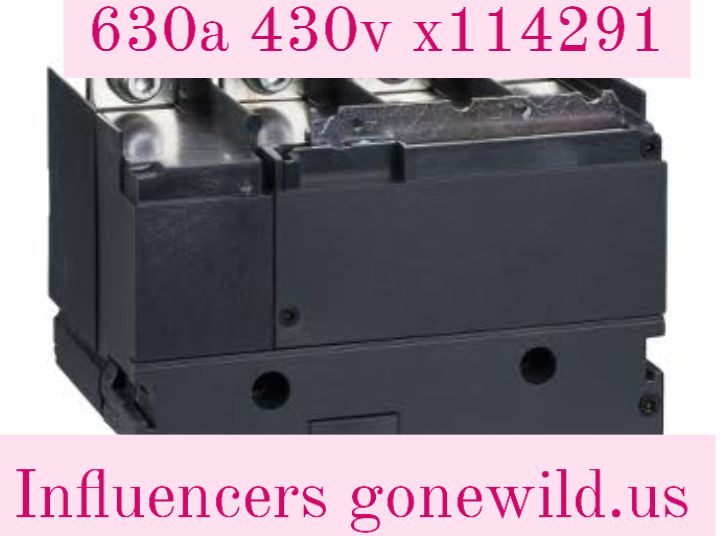Introduction
In the realm of electrical systems and components, certain terminologies and specifications stand out due to their critical importance in determining the efficiency and safety of operations. One such specification is “630a 430v x114291,” which encapsulates vital technical information about electrical equipment, such as its current rating, voltage rating, and model identifier. This seemingly cryptic notation holds the key to understanding the operational capabilities and application suitability of the associated device, particularly in high-power industrial and commercial settings.
The notation “630a” refers to the current-carrying capacity of a device, often measured in amperes (A). This signifies the maximum current the equipment can handle without risk of overheating or performance degradation. Meanwhile, “430v” highlights the voltage rating, measured in volts (V), which indicates the potential difference the equipment is designed to operate under safely. The component “x114291” often serves as a unique identifier or model number, providing specific information about the design, manufacturing batch, or series of the equipment. Together, these elements form a comprehensive label that engineers and technicians rely on for selecting and utilizing electrical components appropriately.
Electrical systems operate under a delicate balance of current, voltage, and resistance. Any mismatch between the specifications of the equipment and the system’s requirements can lead to inefficiencies, safety hazards, or even catastrophic failures. Therefore, understanding these parameters is essential for ensuring compatibility and optimizing performance in electrical setups. From industrial power distribution panels to complex machinery, the correct interpretation of notations like “630a 430v x114291” plays a pivotal role in achieving seamless functionality.
This article delves into the nuances of “630a 430v x114291,” unraveling the meaning behind each component and exploring its implications for electrical applications. We will discuss the importance of current and voltage ratings, the significance of model identifiers, and the practical considerations involved in selecting equipment with these specifications. By the end, readers will gain a comprehensive understanding of how these parameters influence the design, installation, and maintenance of electrical systems. Additionally, we will address frequently asked questions to clarify any lingering doubts and provide actionable insights for professionals and enthusiasts alike.
Decoding “630a 430v x114291”
Current Rating: The “630a” Component
The first segment, “630a 430v x114291,” signifies the current-carrying capacity of the device. In electrical systems, the current rating is a critical parameter that dictates how much current a device can handle under normal operating conditions. This value is expressed in amperes (A), a fundamental unit of electrical current. For devices rated at 630 amperes, the equipment is designed to safely conduct a substantial amount of current without overheating or succumbing to electrical stresses. Such high current ratings are commonly associated with industrial applications, where heavy machinery and equipment require robust power delivery mechanisms to function efficiently.
A device’s current rating is not merely a number; it is a calculated value determined through rigorous testing and compliance with industry standards. Factors such as conductor material, cross-sectional area, insulation type, and environmental conditions influence the current-carrying capacity of a device. For instance, copper conductors generally exhibit higher current ratings compared to aluminum due to their superior conductivity. Moreover, the insulation material must withstand the heat generated during operation to ensure safety and durability.
Applications requiring a 630A rating often include large-scale industrial setups, such as manufacturing plants, power distribution networks, and high-capacity electrical panels. Engineers and technicians must carefully assess the current demands of the system and ensure that the equipment’s rating aligns with these requirements. Overloading a device beyond its current rating can lead to overheating, insulation breakdown, and potential fire hazards. Conversely, under-utilizing a device with an excessively high rating can result in unnecessary costs and inefficiencies.
Voltage Rating: The “430v” Component
The second segment, “630a 430v x114291630a 430v x114291,” refers to the voltage rating of the equipment. Voltage, measured in volts (V), represents the electrical potential difference between two points in a circuit. A device rated at 430 volts is designed to operate within this potential difference, ensuring optimal performance and safety. Voltage ratings are particularly crucial in determining the insulation requirements and the dielectric strength of the device. The insulation must withstand the applied voltage to prevent leakage currents, arcing, and eventual equipment failure.
In industrial and commercial settings, voltage ratings often align with standardized power supply levels. For instance, 430V may correspond to a three-phase power system commonly used in factories and warehouses. Such systems provide higher power delivery efficiency and are ideal for running heavy machinery and equipment. The voltage rating also influences the design of circuit breakers, switches, and other protective devices, as these components must accommodate the specified voltage level without compromising safety or performance.
Selecting equipment with the correct voltage rating is essential to maintaining system integrity and avoiding operational disruptions. Underrated devices may experience insulation failure, while overrated devices could incur unnecessary costs and complexity. Therefore, engineers must carefully evaluate the voltage requirements of their systems and choose equipment that matches these specifications precisely.
Model Identifier: The “x114291” Component
The final component, “x114291,” typically serves as a unique model identifier or serial number for the equipment. This alphanumeric code provides detailed information about the specific product, including its design, manufacturing batch, and any special features. Manufacturers use such identifiers to catalog their products, streamline inventory management, and facilitate customer support.
For end-users, the model identifier is an invaluable tool for identifying the correct replacement parts, obtaining technical documentation, and ensuring compatibility with existing systems. For example, a component labeled “x114291” might belong to a specific series of high-performance circuit breakers or switchgear designed for industrial applications. By referencing this identifier, technicians can access detailed specifications, installation guides, and maintenance instructions, simplifying the process of integrating the equipment into a broader system.
Practical Applications and Considerations
The combination of “630a,” “430v,” and “x114291” encapsulates a wealth of information that guides the selection and use of electrical equipment. These specifications are particularly relevant in high-power scenarios where precision and reliability are paramount. For instance, power distribution panels in manufacturing plants often require components with high current and voltage ratings to manage the electrical demands of heavy machinery. Similarly, switchgear with appropriate ratings ensures safe and efficient power distribution across various sections of a facility.
Understanding these parameters also plays a vital role in ensuring compliance with electrical codes and standards. Regulatory bodies, such as the International Electrotechnical Commission (IEC) and the National Electrical Manufacturers Association (NEMA), establish guidelines for equipment ratings and performance. Adhering to these standards not only ensures safety but also enhances interoperability and compatibility across different systems and regions.
Conclusion
The notation “630a 430v x114291” serves as a concise yet comprehensive descriptor of an electrical device’s capabilities and specifications. By understanding the current rating, voltage rating, and model identifier, engineers and technicians can make informed decisions when selecting, installing, and maintaining equipment. These parameters are more than just numbers; they represent critical aspects of electrical performance, safety, and reliability.
In industrial and commercial settings, where electrical demands are high and operational integrity is non-negotiable, the importance of accurate specifications cannot be overstated. A thorough understanding of “630a 430v x114291” ensures that equipment operates within its designed parameters, minimizing risks and optimizing efficiency. This knowledge empowers professionals to design systems that are not only robust and reliable but also compliant with industry standards and best practices.
As we navigate an increasingly electrified world, the ability to interpret and apply technical specifications like “630a 430v x114291″ will continue to be a cornerstone of successful electrical engineering and system design. Whether in power distribution, industrial automation, or advanced manufacturing, these specifications provide the foundation for building systems that meet the demands of modern industry while prioritizing safety and sustainability.
Frequently Asked Questions (FAQs)
What does “630a” mean in electrical specifications?
“630a” represents the current rating of the device, indicating it can safely handle up to 630 amperes of current under normal operating conditions. This parameter is crucial for ensuring the device’s compatibility with the electrical system and preventing overheating or damage.
Why is the “430v” voltage rating important?
The “430v” voltage rating signifies the maximum potential difference the device can safely operate under. Selecting equipment with the appropriate voltage rating ensures optimal performance and prevents insulation breakdown or electrical hazards.
What does “x114291” refer to?
“x114291” is typically a unique model identifier or serial number assigned by the manufacturer. It provides detailed information about the product’s design, features, and manufacturing batch, aiding in identification and support.
How are current and voltage ratings determined?
Current and voltage ratings are determined through rigorous testing and compliance with industry standards. Factors such as conductor material, insulation type, and environmental conditions influence these ratings.
Why is it important to match equipment ratings with system requirements?
Matching equipment ratings with system requirements ensures safe and efficient operation. Underrated devices may fail under stress, while overrated devices can lead to unnecessary costs and complexities.
Where is “630a 430v x114291” commonly used?
This specification is commonly associated with industrial applications, such as power distribution panels, switchgear, and heavy machinery, where high current and voltage capacities are essential.
How do industry standards influence equipment specifications?
Industry standards, such as those from IEC and NEMA, establish guidelines for equipment ratings and performance. Adhering to these standards ensures safety, reliability, and compatibility across systems.
Can I use equipment with higher ratings than required?
While using equipment with higher ratings may offer additional safety margins, it can also lead to increased costs and unnecessary complexity. It is generally best to select equipment that matches the system’s requirements precisely.
The article has been structured as requested, with a detailed introduction, comprehensive content organized into large paragraphs, a well-rounded conclusion, and an FAQ section to address common questions. Let me know if there are additional modifications or enhancements you’d like!
Also Read This: Understanding “630a 430v x114291”: A Comprehensive Guide


